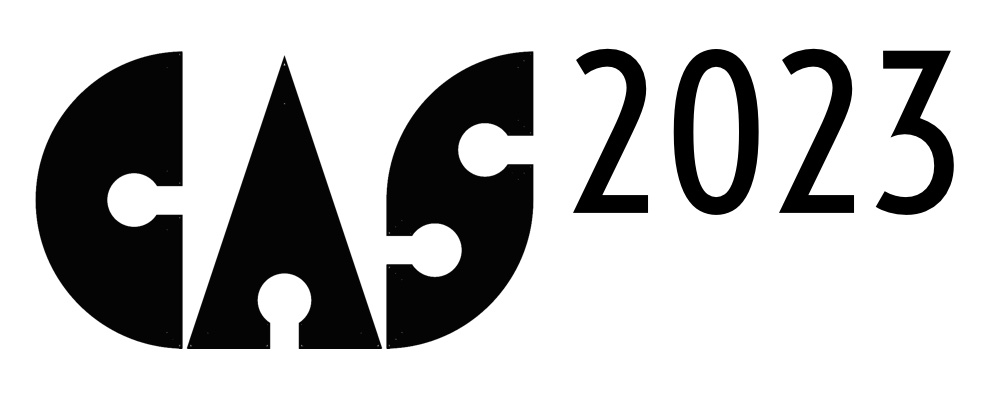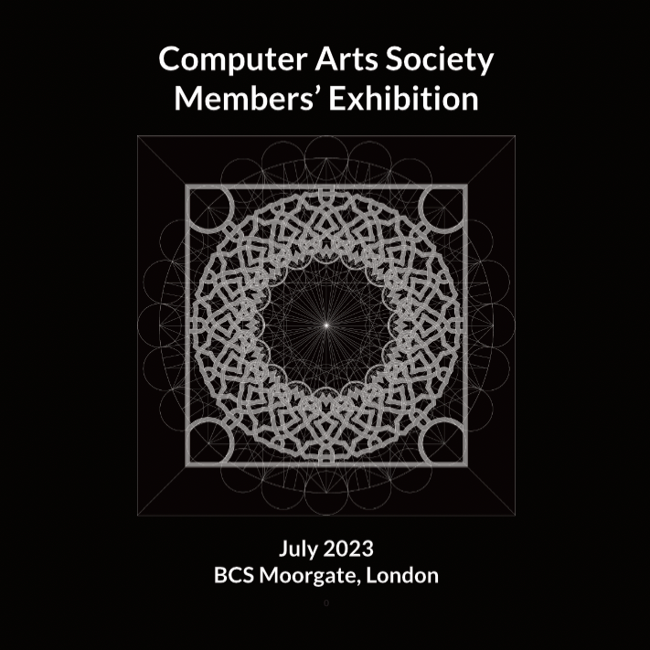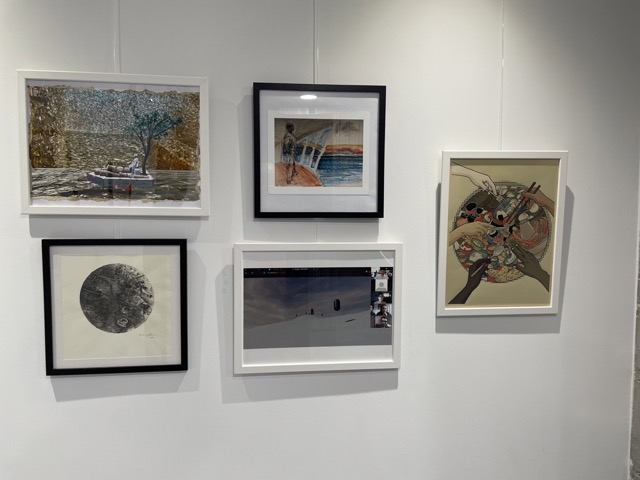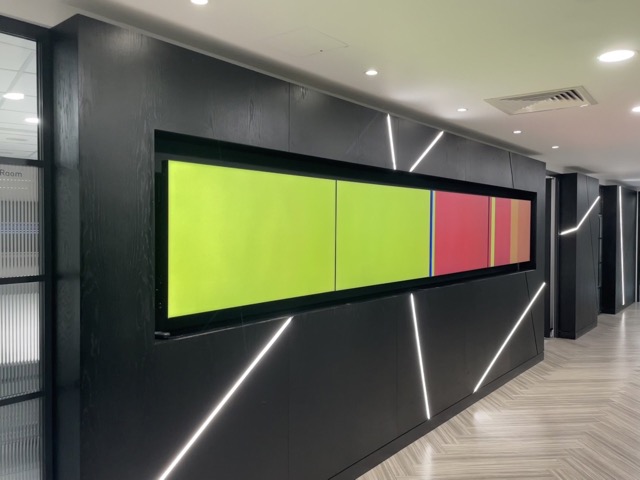CAS Members' Exhibition 2023
July - November 2023
BCS Moorgate, London
The CAS Members' Exhibition 2023 opened on Monday 10th July at BCS London as part of the EVA London 2023 conference. It contains a mixture of submitted and invited artworks that represent the wide variety of work created by members of the Computer Arts Society.
Documentation
Exhibition Catalogue
The exhibition catalogue is available as a free downloadable PDF. A limited number of printed copies are also being made available. Copies can be purchased from the Computer Arts Archive Shop, subject to availability.
CAS Corridor
Work in this area was selected as following a call for artworks sent to CAS members. CAS-curated exhibitions are shown in the "CAS Corridor" throughout the year.
1. Jim Andrews
Metaphysical Book (2023)

I created Metaphysical Book with software I wrote called Aleph Null, which is a graphic synthesizer. One creates 'brushes', which sample from folders of images to create 'brushstrokes' (circular in the case of this brush). We see 5 brushstrokes in Metaphysical Book. The brushstrokes sample from a folder of publicly-licensed images I've been developing for about a decade called Alchemical Cosmography. Most of the underlying images are 9th to 18th century concerned with alchemy and/or cosmography (in the sense of 'images of the cosmos'). I made this particular image specially for CAS. The image is 3803x2591 pixels, which is 483mm x 329mm at 200 dpi, which was is the size it will be printed to.
2. Camille Baker
INTER/her (2021)

An immersive installation and Virtual Reality artwork focussed on reproductive diseases and pain that women experience: endometriosis, fibroids, polyps, Ovarian and other cysts, cervical, ovarian, uterine and endometrial cancers. The sensory and emotional experience moving from the outside in within a real dome space into VR space, with a 3D audio soundscape of the voices and stories of real women recounting their experiences, making it an intimate, emotional and possibly haunting experience, with accompanying wearable haptic garment providing a visceral vibration responsive experience on the lower abdomen, where the various diseases occur.
3. Graham Bate
Eight Hours (2023)
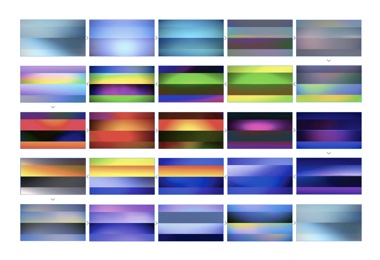
Eight Hours shows a progression of still images drawn from an eight hour silent movie entitled Moving Painting Four. The print captures the continual flow of the movie in a static sequence. Moving Painting Four creates a quiet space for tranquil, contemplative encounters with the self. It offers a continuous, slow, imperceptibly changing visual panorama and is meant to be experienced like a painting rather than watched like a film.
4. Stephen Bell
2 Predators 98 Prey (1985)

Image generated by 'Smallworld' C program running on VAX 11/750, photographed from Sigmex screen. Coded by the artist when Artist in Residence in the Computing Laboratory of the University of Kent at Canterbury, sponsored by The Arts Council and South East Arts.
5. Paul Brown
Wrapping Paper (2017)

Wrapping Paper is a chance outcome of one of my current works in progress. I was looking for a complete set of tiles that would enable a complex overlaid image to be coloured consistently. I required six colours and for ease I used the three primaries and their complements. I created the tile set then randomly put some together and the result was this image. In the longer term I will be using this tile set and their transforms to create a generative animation and will also investigate different rotations of the colour wheel in order to pursue some more subtle variations.
6. Sara Choudhrey
Santiponce Black (2019)
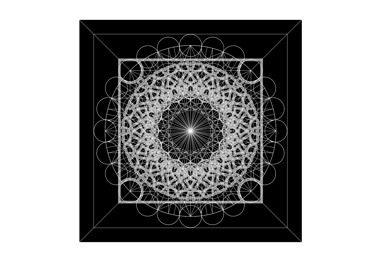
Santiponce Black was produced as an outcome for the design and development of an interactive installation (Santiponce, 2018). The composition demonstrates analysis of the underlying 16-fold geometry and presents this as a documentation of process and continuity in pattern-making whilst adhering to traditional practices.
7. Geoff Davis
Pattern City (2023)

Patterned city shines,
In its weave, life intertwines,
Chance frames the design.
Woven dreams shine bright,
In the city's hushed twilight,
Errors take their flight.
8. Anna Dumitriu
Physic AI Garden (2023)

This still image was extracted from Physic AI Garden, an interactive dynamic digital garden, where beautiful virtual plants and fungi grow and interact with each other and with audiences. The artwork is a collaboration between artists Anna Dumitriu and Alex May with the EU CAPABLE project. The plants each represent different drugs, and the garden grows according to what drugs work well together and what drugs cause side effects or interact negatively. Side effects represented through blemishes on the plant leaves and a healthy ecosystem is represented by insects and arachnids. The artwork is based on actual data of drug interactions and the AI system that underpins the CAPABLE decision support system for doctors. The project is influenced by the medieval concept of the ‘physic garden’ of medicinal plants, and also inspired by notions of permaculture which puts plants that grow well together close to each other, considers the whole ecosystem. “Physic-AI Garden” has been commissioned by the CAPABLE Project. CAPABLE has received funding from the European Union’s Horizon 2020 research and innovation programme under grant agreement No 875052.
9. Patrick Lichty
Studio Visit: Studio of Audra Pancake (2022/2023)
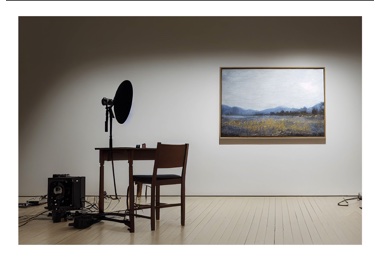
Studio Visits: In the Posthuman Studio is a speculative exhibition of 50 AI artists visited by a human curator. Created in the form of a catalog created before the exhibition, the project recalls Duchamp;'s Boite en Valise as a self-contained synthetic exhibition. Containing GPT-3 generated statements paired to "empty" renderings of artist's studios, Studio Visits reflects on contemporary anxieties about AI. The cover image of the studio of landscape photographer Audra Pancake, an artist who her "photography and sound work, represent the breathtaking beauty of nature, but also highlight the importance of preserving and protecting these special places for future generations." (Courtesy GPT-3)
10. Luciana Haill
Pioneer (2021)

The image shows the artwork appearing on the screen of a smartphone using the Pioneer AR augmented reality app. It triggers the unique Victorian seagoing electric train on stilts invented by Magnus Volk called Pioneer (1896-1901) that was affectionately referred to as the ‘Daddy Long Legs’. Pioneer embodies the futuristic from 1896 with the fantastic, in an ambitious and fragile touristic mode of travel. The AR artwork is geotagged onto its steel rails in the rockpools, and by visiting its original route in Brighton between Kemptown seafront and Rottingdean, the Pioneer and its musical hall soundscape travels again. Pioneer was funded by The Arts Council of England.
11. John Hovig
Endymion (2023)

Endymion represents the pursuit of visual ecstasy through aesthetic form, a spirited example of Hovig’s exploration of human mark-making. Despite his degree in artificial intelligence, the software uses only simple rules—like Sol LeWitt—to produce energetic linework, vigorous color palettes, and captivating complexity. He custom-wrote its generative software to emulate the line drawings he made before Covid lockdowns.
12. Dlela Lombard
Tree of Life (2023)

The foundation for this piece or discovery is formless photo pixel content, a nothingness of blurred green outdoors. It was manipulated in an intuitive flow after 'breaking up' with photography and continued in Photoshop without AI until new imaginative forms appeared.I did this on a labtop while often moving around in Germany. Somehow the movement translated into an intuitive flow of process making some invisible forms visible which may be a similar process to analogue development. Because it was nothing to begin with akin to a blank canvas, I called the results Ex Nihilo.
13. Alex May
A Kolkata: The Forest of Stories (2021)
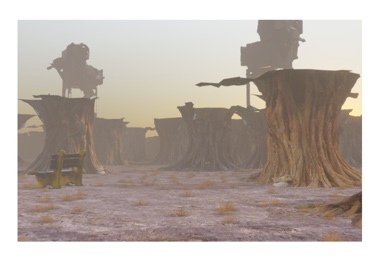
"A Kolkata" is a video artwork made in remote collaboration with four Kolkata-based photographers that reflects on the experience of having physically travelled to a place compared to exploring it through books, historical record, images, film, and digital means. Created from May's participation in the Indo-European Residency 2021 that selected five artists from five different countries (India, France, Germany, Italy, and the UK), the work is made using photogrammetry 3d scans of locations and objects in Kolkata, selected and photographed by the collaborators, that were then processed and combined into animated scenes that elicit the sense of being in a place that exists only in the dream of the artist.
14. Tivon Rice
Circular Conversations (2020)
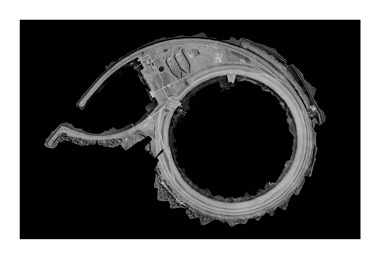
Het Ijsseloog, or The Eye of the Ijssel, is a manufactured island, a container for toxic sediment unearthed during the creation of Flevoland province in the Netherlands. This photogrammetric scan was rendered from over 300 photos captured on multiple drone flights, a process that amplifies the artificiality of the landscape. The resulting 3D model was also central in Rice's experimental video "Models for Environmental Literacy" which pairs photogrammetric animations with A.I. generated narratives.
15. Jack Tait
Light Beads (2019)

NSEW drawing machine using a variable colour and image size light pen recorded onto a Canon EOS MK II camera.
16. Ian Truelove
Human Centred (2023)

The human face at the centre of this artwork was painted by a human hand, but the eight images surrounding it were painted by Adobe Photoshop’s AI-powered Generative Fill tool. As we grapple with what it means to be a human artist in an AI-powered world, this artwork seeks to heighten some of the AI-fuelled tensions that relate to authorship and authenticity.
17. Anna UrsynTwo Skies (2023)
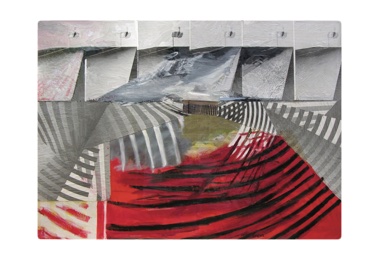
The significant characteristic of the Western range is its legend of severe nature and austere cowboy life contrasted with the beauty of red rocks and changing sky. The way we communicate changes and expands, thus allowing us for new strategies, solutions, and systems. Computer codes were juxtaposed with photographic material and painterly markings.
18. Mark Webster
Neural Paths (2022)

This image is one of many test images that were part of the development for Neural Drawings which is a series of hand printed artworks that began in late 2021. The initial idea for this series took inspiration from Santiago Ramón Cajal’s illustrations of neurones. This body of work also builds on earlier personal thoughts revolving around the theme of memory and emotion. I'm interested in the role that emotion has to play in memory and consequently how we construct as well as deconstruct thoughts. These ideas are accompanied by my readings of Antonio Damasio, Oliver Sacks, Robert Sapolsky and Lisa Feldman Barrett.
19. Marcus West
Radiating Light Generates a Fibonacci Structure (2023)

The image represents a kind of mystical realm emanating light, in the form of the red and yellow “rays” which radiate from the image’s centre. The outer ends of these “rays” act, rather like the top of columns in a cathedral, as platforms from which a tracery of elements spring, to manifest a three dimensional structure in the physical world. The geometry of the image is based on the Fibonacci series, (the sequence of numbers related to the Golden Ratio, that lies at the heart of the familiar spiral patterns seen in the centre of a sunflower seed-head and in many other growth patterns in nature).
20. Corinne Whitaker
Watching Tomorrow Grow (2023)

A unique multi-media digital painting in eco-friendly LED lighted aluminum box. Whitaker has been a pioneering digital image-maker and sculptor for 49 years, winner of 2 Golden Web awards and an Academic Excellence Award. Her focus has been in developing a new iconography of visualization for a new era in humanity’s understanding of itself. Her use of AI has extended to 3D printing, music composition and lyrics as well as painting.
Four-panel Screen
Ernest EdmondsColour Energy (2010)

Colour Energy was commissioned for the 2010 Vivid Festival in Sydney, Australia. It was shown on Grid Gallery, a 16x1 metre screen in the street, at eye level. Colour Energy was a late example from the Video Construct series of computer-generated movies first made in the 1980s. It was also influenced by the Shaping Form interactive works that had been shown from 2007. This work has been adapted for the BCS large screen.
Wilkes Room
Aphra Shemza
shemza.digital #10 (2022) • shemza.digital #11 (2022) • shemza.digital #12 (2022)

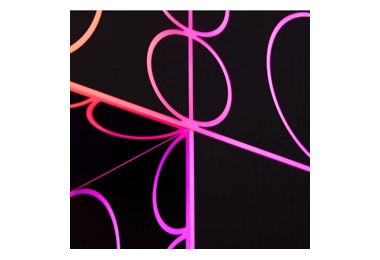
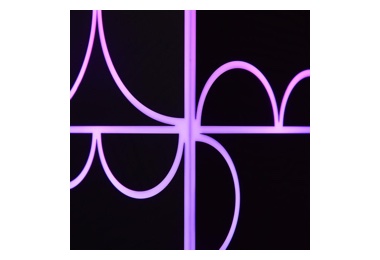
Enjoy the abstract shapes and neon colors of shemza.digital with this brand new set of limited edition prints. The prints are photographs of the original interactive light art sculpture shemza.digital #6. The shemza.digital project is based on the work of the world renowned British/Pakistani painter Anwar Jalal Shemza alongside the contemporary practice of Aphra Shemza, the artist’s granddaughter. The shemza.digital project, launched in collaboration with Stuart Batchelor in 2020, extends Shemza’s legacy for current and future generations by creating accessible art with and for the public.
Lovelace Room
Sean Clark
Computational Constructs
0623.1 (2023) • 0623.2 (2023) • 0623.3 (2023)



Sean Clark is an independent artist, curator, and researcher based in Leicestershire, UK. His artwork explores interaction and connectedness through the construction of audiovisual systems presented on screen, as installations, and as prints. He is the director of Interact Digital Arts and the curator of the Computer Arts Archive. He has a PhD in Computational Art from De Montfort University and in 2016 was co-winner of the Lumen Prize for 3D/Sculpture and the Art.CHI Digital Art Prize.
Flowers Room
Brian Reffin Smith
You too can paint "An Al generated sculpture of Marlene Dietrich having breakfast with Damien Hirst in the style of Jeff Koons" (2023) • Paint your own computer art #14 (Painting by numbers) (2023) • Pistol Bridge (2022)


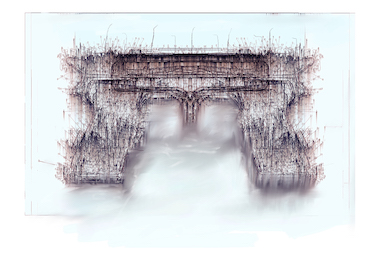
My painting by number (PBN) computer-based works offer an invitation, to colour in the numbered zones; and a refusal, or several. They could not have been made without the computer's prompting. The complexity of the numbers and arrows preclude any colouring-in. There are no brushes or paints provided. That there is a coloured version of the breakfast scene, and that the data of Pistol Bridge have been sort-of hand coloured but not coloured-in, isolates the codes from any art-like 'reality' even more. This reinforces the idea that the PBN codes become the artwork itself. The reduction-yet-addition of information mirrors the reality, for me, of the real world. Just stuff - the rest (beauty, red, emotion, ekphrasis etc.) is merely our brain telling us (more or less useful) lies. And blah blah, but you know what I mean.
Shirley Room
Graham Diprose
Escape From Flatland (2007)


3D Anaglyph photography of a subject, by shooting simultaneously from two slightly different angles through red and cyan filters, dates back to the 1890s. It was particularly popular in some 1920-1940s movie productions. In 2007, I was ‘beta testing’ two new Leaf digital backs for Hasselblad cameras and decided to set up this experiment. Martina wore a turquoise dress to keep all the colours as natural as possible. Using some of the highest resolution digital equipment of the day, and assembling the pair of images in Photoshop, this research was published by EVA London in 2007.
Spark Jones Room
Work in this area is from artists in the A-Maze Artists' Collective. A-Maze Artists' Collective is woman-led and includes practitioners of all ages & diverse cultural backgrounds with a wide range of artistic and technical skills. The collaboration grew out of a particular historical moment, the Covid19 pandemic. The crisis showed us how interconnected we all are and how, if we can just change one thing in our lives, it has an impact on everything else. Fion Gunn initiated the collective in March 2020 and she and Maureen Kendal are co-leads in the group.
Fion Gunn
Sailing to Byzantium (2023)

This is a snapshot of an environment I created in Tiltbrush, firstly making the vessel, the tree and scrolls, then importing a 3D model of myself and painting the clothes around it. Next, I imported videos of the gold background which I’d filmed in Venice and the sea, which I filmed in Liverpool. The title refers to the poem which inspired me -‘Sailing to Byzantium’ by W.B.Yeats.
Nazia Parvez
Digital Twilight (2019)
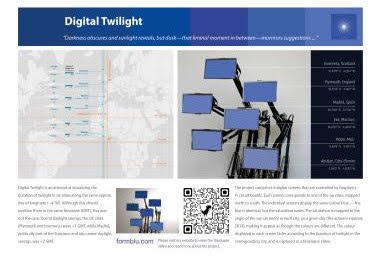
Digital Twilight is an attempt at visualizing the duration of twilight in six cities along the same approx. line of longitude (~4° W). The project comprises 6 digital screens that are controlled by Raspberry Pi circuit boards. Each screen corresponds to one of the six cities, mapped north to south, and displays a color which fades according to the duration of twilight in that location.
Shoran Jiang
Food Presents (2023)

“Food Present” is an immersive journey that transcends boundaries and embraces the beauty of diversity, interweaving cultures and traditions through a shared appreciation for the art of food. I invite you to explore this AR artwork, and witness the power of unity, creativity, and culinary delights as they converge before your eyes. “Food Present” evokes the enchantment of childhood wonder, co-created by the children themselves. Their drawings come to life in AR, weaving themselves into a gastronomic vision. These imaginative artworks embody the boundless imagination and inventive spirit of young minds, reminding us of the limitless possibilities that arise when we embrace our creativity.
Maureen Kendal
Looking Towards the Land (2023)

The series of drawings are the first stage in the artist’s creation of electronic collaged movies using framing, capture, edit, animated effects and audio to weave together personal moments of experience into narratives combining figurative and abstract visual and sound language. Maureen’s Artwork uses four different exploratory adventures experienced since the release from the CoVid Lockdown, framed and captured by the artist on visits to Deptford-London , Ecuador, Uzbekistan and Israel. the artist is asking psychological/ philosophical/ logical/ poetic/ personal questions around how we as humans, (as distinct from human-mediated machines) experience ‘place’.
Ardern Hulme-Beaman
Transitions - Prehistoric Crane Feet (2023)

Ardern has been exploring Parkgate on the Wirral peninsula which has had buildings on the waterfront from the 1700s with architecture like that of Deptford on the Thames. The sea has receded and wetlands have grown, it’s the perfect example of transitions. Those Wetlands are the same as those from 5000BP. and would have supported species like crane. This image of crane footprints from 8-4000 BP forms the basis of the short animation featured in the A-Maze artists’ film compilation.
Audrey Mullins
Elements on Glass (2017)

These artworks are from Audrey’s ‘Language of Landscape’ series. The artist cuts, pastes and assembles, these are key processes in her work. She begins by reducing objects to their geometric forms and spreading them across the surface of a landscape, inspired by Chinese ink painting. She deconstructs and rebuilds the surface so that objects are unrecognizable but resemble undecipherable scripts. The rebuilding process is built up slowly, referencing written language but not any specific one. There is no translation. The forms are purely visual.‘Drifting Time Series’ 2020.
Chen Mei-Tsen
Drifting Life Series (2020)

Chen Mei-Tsen believes that our human lives are analogous to the lives of jellyfish, the relationship of the human ecosystem for her personal research observing nature and understanding where the ‘right’ place for human beings lies, what is our interaction with other living beings, how we live together, where can we find a harmonious way to live together on the planet. This is what we see in mythological narratives and imagery also, ways of inhabiting other life forms in our imaginations where for example, she could be a jellyfish, a tree. We imagine another way of being in order to develop new perceptions and perspectives on our place in the universe. These artworks were created alongside Mei-Tsen’s similar virtual space.
Alan Hudson
Light-Wind-Tide (2023)

We are all familiar with energy production from solar panels and from wind turbines. These two sources have been extensively developed and implemented all over the world. Tidal and wave power both have a long history of research but have not been implemented to the same degree. Nowhere in the UK is more than 84 miles from the sea. Many towns and cities have rivers flowing through their centres. Hot springs emerge in the centre of the City of Bath which deliver over a million litres of water every day at a temperature of over 45 degrees C. This work explores electricity generation using Light, Wind, and Tide, in an engaging and interactive way, emphasising how underdeveloped these resources are.
Freddie Sanders
Screenshot of Burgage (2021)

This is web-based multiplayer virtual world made using Geographic Information Systems (GIS) and photogrammetry and designed in an open access game engine. Burgage orbits around three pivotal concerns: sharing, space, and art. We do not see ourselves as one singular entity. Instead, we are more of a network - a rhizome of ideas and resource sharing, never static, always responding to our current situation and catalysing the imagination in whatever way we see fit.
Community Area
Computer Arts Archive Shop
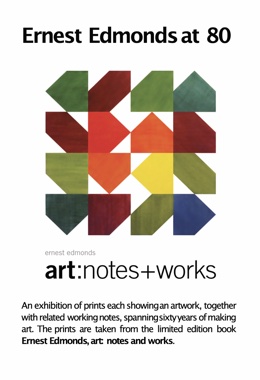

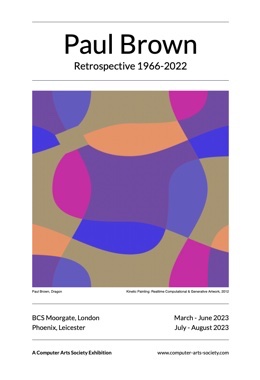
Prints and catalogues from previous Computer Arts Socity exhibitions are available from the Computer Arts Archive Shop. All proceeds from sales go towards the running of the Computer Arts Archive.
Analema Group
KIMA: Noise Maxilla (2019) • KIMA: Colour - Monet 002 (2020)


The Analema Group explores the intersection of sound and matter through participatory art. Their signature project KIMA explores visual representations of sound. KIMA: Noise explores the effect of urban noise on health and well-being, displaying noise pollution around the Tate Modern where the noise levels exceed 80 decibels during daytime, with severe health impact on local residents. KIMA: Colour, commissioned by the National Gallery X, sonifies colours in Monet's 'Water Lillies, Setting Sun' while providing an immersive audio-visual experience through 360 sound and video. Both KIMA Colour and KIMA: Noise form part of the AHRC-funded p_ART_icipate research project on the effect of participatory art on wellbeing.
Studio Rokoko
Gainsborough (2023) • Little VersailleX (2023)

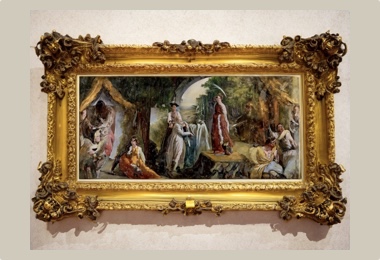
A collaborative creative entity sometimes referred to as Drucilla Burrell and Magdalene Celeste. Together they have more than 20 years in the fields of fashion, costume design, styling, creative direction, art and photography. Their work focuses on the whimsical Queering of historical narratives and codifiers using contemporary technology and self portraiture.
Fion Gunn
The Dreams of City Dwellers (2012)
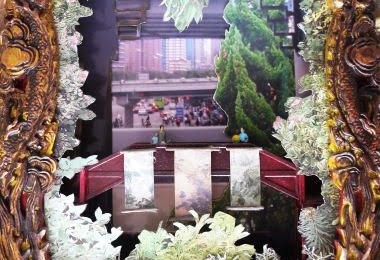
I made this artwork in response to working in Beiing. It is such a hardcore polluted urban environment and yet at the heart of Chinese culture is a profound feeling for the natural world, one which is layered with fantasy nowadays…. I used photos that I took at Jiangguomen, painted on them, added collage and a miniature bridge from which hang tiny scrolls of traditional Chinese landscapes. The piece is made inside a frame which was used to export a brick of Chinese tea more than 50 years ago. It is a miniaturised 3D window into Beijing life as I have felt it.
Jack Copeland, Peter Fitzpatrick, Vicki Hyde
Turing Diptych (2016)

This artwork came about after a mock-up digital artwork by Jonathan Bowen in the style of Andy Warhol for the cover of a book about Alan Turing, "The Turing Guide" (Oxford University Press, 2017), by Jack Copeland, Jonathan Bowen, Robin Wilson, Mark Sprevak, et al. Jack Copeland then organized a more professional artwork, as shown here, which became the basis for the eventual book cover.
Andy Lomas
Chemotaxis3D9 0002 0694 0950 (2023)

Explorations of digital simulation of chemotaxis, the process by which cells migrate following spatial cues. Inspired by the social amoeba Dictyostelium discoideum, propagating periodic waves of chemicals influence the movement of cells as well as being amplified by the cells to express a wide range of rich dynamic behaviour. This image is from a simulation of 26,843,546 cells that starts with completely random positions but through chemical signals organise themselves into complex structured forms.
Stephen Scrivener
Homeostasis (2022)
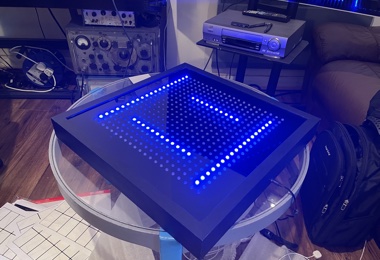
Working in collaboration with fellow artist Sean Clark, Stephen Scrivener has created Homeostasis, an augmented reconstruction of his 1970s artwork The Machine. The underlying system is unchanged, and the physical display is a near reproduction using modern LEDs embedded in an acrylic panel. Thye artwork is able to run in a self-contained or interactive mode.
Jon Weinel
Cyberdream (2021)

Cyberdream is a virtual reality application, which provides a journey through audio-visual environments based on the aesthetics of 1990s rave music. The piece incorporates original rave music compositions which are blended to form a continuous experience similar to a DJ or VJ mix. The project also incorporates three ‘audio-visual sound toys', which allow the user to interactively 'paint with sound', thereby facilitating creative play. Through its structural form and audio-visual sound toys, Cyberdream indicates new approaches for the design of music visualisations that harness the spatial properties of virtual reality.
Karoline Winzer
Mycelium (2021)
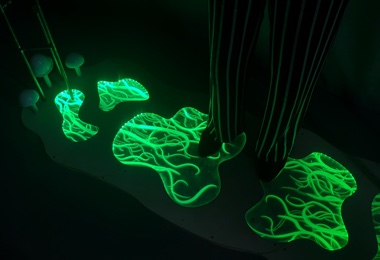
Merging touch, sound, bioelectricity, and physical computing, Mycelium is an interactive experience designed to tangibly visualise the power of connection. The installation is conceptually parallel to networks of underground fungi called mycelium, which collaborate to connect forest ecosystems. Just like the mycelial system, this installation only works when each member plays their part - and when they do, incredible things happen.
Olive GingrichDress to Kill (2022)

Dress to Kill is a remake of a classic scene of Brian DePalma's Dressed to Kill (1980), told a contemporary lens: While the original film was marred by controversy due to its implied homophobia, exorsexism and enbyphobia, Dress to Kill reinterprets gender roles. Historically, Hollywood cinema often associated cross-cressing with criminality or mental illness (Pyscho, Silence of the Lambs). Dress to Kill (2022) seeks to right the wrongs of the past, in showing female empowerment, and cross-dressing as free from the nimbus so often ascribed to it, following the two protagonists (Caroline Salmao, Dolly Trolly) in this classic chase scene.
Video Showreel
- Alex May - A Kolkata(0:0)
- Anna Dumitriu & Alex May - PhysicAI Garden (1:10)
- A-Maze Artists (3:16)
- Andy Lomas - Chemotaxis Transformations (9:16)
- Paul Brown - 4^16 (14:46)
- John Weinel - Cyberdream (16:14)
- Olive Gingrich - Dress to Kill (21:38)
- Daniela Mare - IncognitoDe Paulisv(21:52)
- Graham Bate - Moving Painting Four (25:13)
Credits
The CAS Members' Exhibition 2023 was curated by Sean Clark and Graham Diprose from the Computer Arts Society, with support from the CAS Organising Committee. Thank you to the contributing artists for being involved in the exhibition and helping with the installation. Thanks also to the BCS for supporting the project.
